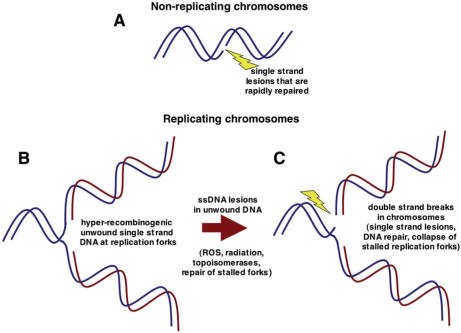Figure 2.
The unique structure of replicating DNA contributes to genome instability at replication forks, which is enhanced by replication fork stalling. (A) When non-replicating DNA molecules suffer single-strand lesions, the integrity of these molecules is maintained by hydrogen bond base pairing on either side of the lesions until they are repaired. (B) Replicating DNA molecules contain single-strand DNA at replication forks after unwinding of double-strand template DNA has occurred in preparation for template-directed DNA synthesis. This single-strand DNA is highly recombinogenic. (C) Single-strand DNA at replication forks is susceptible to single-strand lesions that effectively produce double-strand breaks. Double-strand breaks also occur at stalled replication forks in association with attempts to repair the stalled forks and/or due to replication fork collapse in the absence of checkpoint functions.

